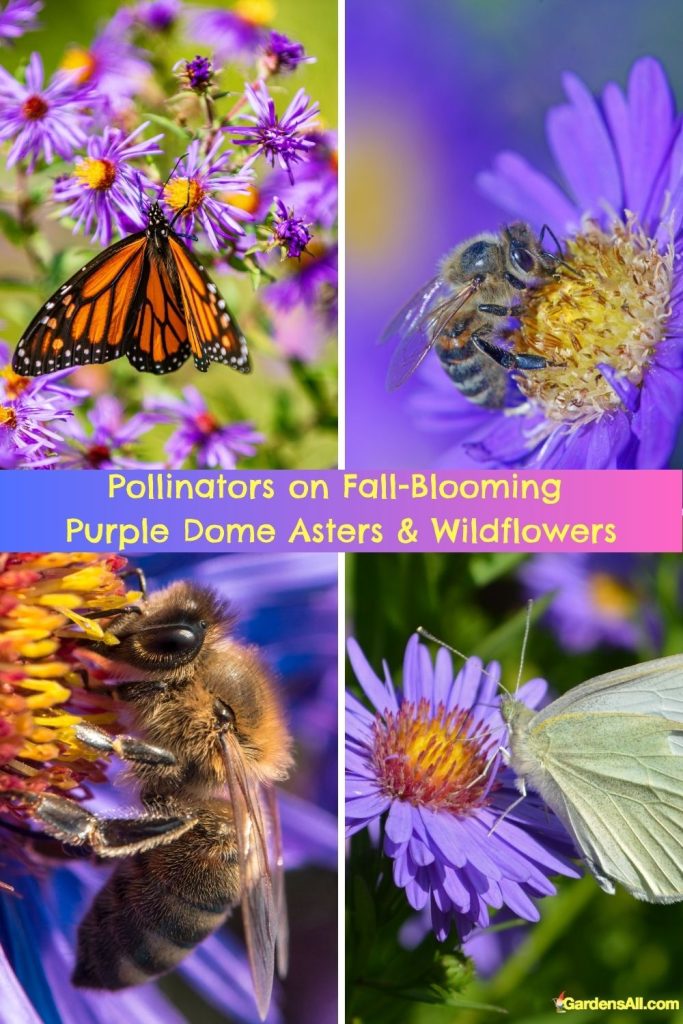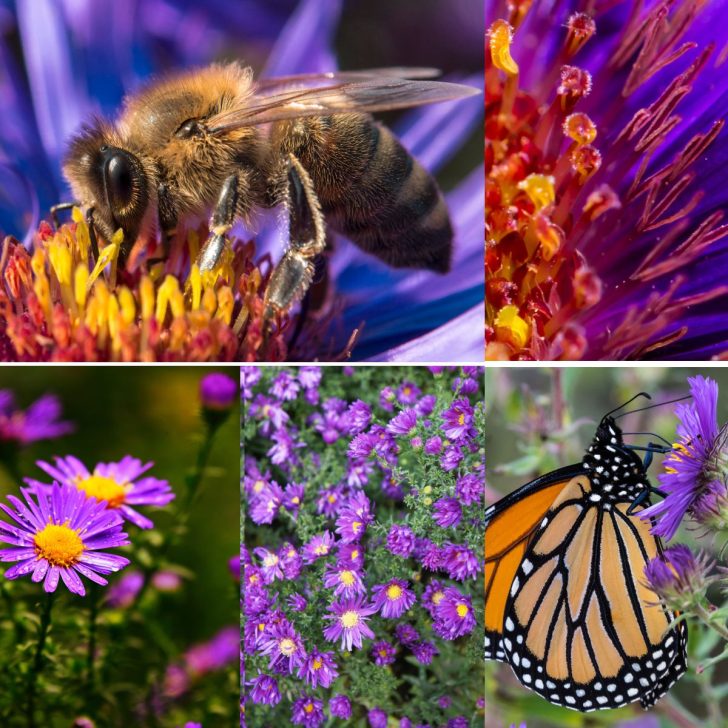A Beautiful and Beneficial Fall-Blooming Flower for Pollinators (and People)!
The Purple Dome Aster is a captivating perennial that graces yards and gardens with vibrant purple hues and delicate blossoms. This Symphyotrichum novae-angliae ‘Purple Dome’ is a cultivar of the purple aster wildflower, Symphyotrichum novae-angliae.
About Purple Dome Aster
Purple Dome Aster Names
- Scientific Name: Symphyotrichum novae-angliae ‘Purple Dome’
- Common Names: New England Aster, Michaelmas Daisy
Hardiness and Habitat
- USDA Hardiness Zones: 4-8
- Regions Found: North America, especially in the northeastern regions
- Habitat: Meadows, prairies, and open woodlands
Growing Information
- Life Cycle: Perennial
- Soil: Well-draining, moderately fertile
- Sun: Full to partial
- Invasive: No
- Bloom Time: Late summer to fall (August to October)
- Fragrance: No
Uses and Benefits
- Edible parts: The flowers and leaves are edible. The flowers add a lovely touch of color to salads, and the leaves imbue hints of a medicinal herb. Both, fresh or dried leaves and blossom can also be steeped to make teas and tisanes.
- Medicinal uses or benefits: Traditionally, the flowers and leaves are used for respiratory ailments and fever relief. Additionally, teas made from the plant have been used for their calming properties.
- Wildlife: Attracts butterflies, bees, and other pollinators.
Description
- Plant Size & Appearance: Typically grows to a height of 18-24 inches with a similar spread. Compact and mounded growth habit.
- Blossom Size & Appearance: Vibrant purple flowers with yellow centers, each blossom measuring about 1-1.5 inches across.
- Leaf Size & Shape Description: Lance-shaped leaves that are medium green in color, measuring about 2-4 inches in length.
The Purple Dome Aster is a standout in any garden or landscape setting. Its vibrant purple blossoms contrast beautifully with its green foliage, making it a favorite among gardeners and nature enthusiasts alike. Plus… like it’s relatives Calico Aster and Daisy Fleabane, it’s another wonderful plant with benefits!

Purple Dome Aster Taxonomy
- Kingdom: Plantae
- Division (or Phylum): Magnoliophyta
- Class: Magnoliopsida
- Order: Asterales
- Family: Asteraceae
- Genus:Symphyotrichum
- Species: S. novae-angliae ‘Purple Dome’
- Genus:Symphyotrichum
- Family: Asteraceae
- Order: Asterales
- Class: Magnoliopsida
- Division (or Phylum): Magnoliophyta
The species name, novae-angliae, originates from Latin, meaning “of New England,” reflecting its native region.

Where Does Purple Dome Aster Grow?
This aster, thrives in the northeastern regions of North America. It can be commonly found in meadows, prairies, and open woodlands. This plant prefers full to partial sun and well-draining soil, making it a versatile choice for various garden settings. Whether you’re looking to attract wildlife or simply add a splash of color to your garden, this aster is an excellent choice.
Uses and Benefits
- Edible parts: Both the flowers and leaves are edible. The flowers can add a splash of color to salads, while the leaves can be steeped to make teas and tisanes.
- Medicinal uses or benefits: Traditionally used for respiratory ailments and fever relief. Additionally, teas made from the plant have been used for their calming properties.
- Wildlife: Attracts butterflies, bees, and other pollinators.

Purple Dome Aster vs. Purple Aster Wildflower
Both the Purple Dome Aster and the Purple Aster Wildflower belong to the same genus, Symphyotrichum, and share many similarities. However, they are not exactly the same. The distinction primarily lies in their specific cultivars and characteristics.
Similarities:
- Genus and Species: Both plants belong to the genus Symphyotrichum and the species novae-angliae. This means they share a common lineage and have many similar traits.
- Native Region: Both plants are native to North America, especially the northeastern regions.
- Habitat: They thrive in meadows, prairies, and open woodlands.
- Appearance: Both plants boast vibrant purple flowers with yellow centers.
- Wildlife Attraction: Both varieties attract butterflies, bees, and other pollinators.
Differences:
- Cultivar: The Purple Dome Aster is a specific cultivar of Symphyotrichum novae-angliae known as ‘Purple Dome’. This means it has been selectively bred for certain desirable characteristics. On the other hand, the Purple Aster Wildflower refers to the species in its wild or native form without specific selective breeding.
- Plant Size: The Purple Dome Aster is known for its compact and mounded growth habit, typically reaching a height of 18-24 inches. In contrast, the wild type Purple Aster Wildflower can grow taller, often reaching heights of up to 6 feet in ideal conditions.
- Bloom Size: While both plants have similar-looking flowers, the Purple Dome Aster’s blossoms are often smaller and more densely packed due to its compact nature.
- Growth Habit: The Purple Dome Aster has a more controlled and dense growth pattern, making it a popular choice for garden landscapes. The wild type Purple Aster Wildflower has a more sprawling and natural growth habit.
So while the Purple Dome Aster and the Purple Aster Wildflower share the same genus and species, they differ in their specific cultivars and some characteristics. The Purple Dome Aster is a selectively bred version with a more compact growth habit, while the Purple Aster Wildflower represents the species in its more natural and wild form.
Both plants, however, offer vibrant colors and are a boon for pollinators, making them valuable additions to gardens and natural landscapes alike.
You may also enjoy our article on purple flowers that bloom in fall, for more lovely options.

I’m LeAura Alderson, a garden, herb and plant enthusiast with a passion for discovering the many edible and medicinal benefits of the plants all around us, including the weeds! I’m a writer, editor and media publisher for our family of websites.
While I was certified in fitness and life coaching, I am NOT a health practitioner. However, I’m a lifelong health enthusiast, with a keen interest in healthy, organic foods and making home remedies and the content we share is from our own experience and usage as well as that extracted from scientific research so that you can explore further on your own.
Always seek the advice and guidance of your health practitioners first and foremost.
As a family we’re steadily expanding our gardening, experimentation and knowledge around all things gardening, edible landscaping, fresh organic foods and self sustainability with farming in our future. I also own and manage iCreateDaily.com, a site all about transformation through creation, and the power of positivity, optimism and mindset.

